UV Fused Silica Plano-Convex Textured Broadband Antireflective Lenses

- Antireflective Performance Provided by Subwavelength Surface Structures
- <0.25% Average Reflectance in the Visible and NIR
- Ideal for Applications Requiring Long-Term Beam Stability
For a detailed comparison between the T1 textured surfaces and Thorlabs' AR coatings, see the Comparison tab.
Lower Reflectance Over a Broad Wavelength Range*
Higher Laser Damage Threshold*
Lower Angular Sensitivity*
*When Compared to Thorlabs' -UV, -A, -AB, and -B
Broadband Antireflective (BBAR) Coatings
LA4148T1
(Ø1", Unmounted)
LA4148T1-ML
(Ø1", Mounted)

Please Wait
| Common Specifications | |||
|---|---|---|---|
| Available Diameter | 1" | ||
| Lens Shape | Plano-Convex | ||
| Substrate Material | UV-Grade Fused Silicaa | ||
| AR Wavelength Range | 400 - 1100 nm (T1 Textured Surface) | ||
| Reflectance over Wavelength Range (Avg.)b |
<0.25% Per Surface | ||
| Transmission Over Wavelength Rangeb |
Tabs ≥ 98% | ||
| Design Wavelength | 587.6 nm | ||
| Index of Refraction | 1.458 @ 587.6 nm | ||
| Surface Flatness (Plano Side) |
≤λ/2 @ 633 nm | ||
| Spherical Surface Power (Convex Side)c |
≤3λ/2 @ 633 nm | ||
| Surface Irregularity (Peak to Valley) |
≤λ/4 @ 633 nm | ||
| Diameter Tolerance | +0.0 mm / -0.1 mm | ||
| Thickness Tolerance | ±0.1 mm | ||
| Surface Quality | 20-10 Scratch-Dig | ||
| Centration | <3 arcmin | ||
| Damage Thresholdd | >30 J/cm2 at 532 nm, 10 ns, 10 Hz, Ø0.4 mm |
||
| Abbe Number | 67.82 | ||
| Clear Aperture | > Ø22.86 mm | ||
| Focal Length Tolerance | ±1% | ||
| Reflectance Data (Click for Graph) |
Raw Data |
||
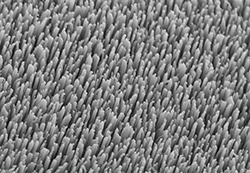
Click to Enlarge
Scanning electron microscope (SEM) image showing a top-view of a T1 textured surface on a UV fused silica substrate.
Features
- Ø1", 50 mm Focal Length Available
- Available Unmounted or Mounted in an SM1-Threaded Mount
- T1 Antireflective Textured Surface on Both Sides
- AR Surfaces Designed for Wavelengths from 400 to 1100 nm
- <0.25% Average Reflectance per Antireflective Surface
- >98% Transmission
- Ideal for Visible and NIR Applications Requiring Long-Term Beam Stability
- High Resistance to Laser-Induced Damage
Thorlabs' Textured Antireflective (AR) Lenses are high-performance UV fused silica (UVFS) lenses with nanostructured surfaces, resulting in ≥98% transmission in the visible to NIR range (400 - 1100 nm). In contrast to AR coatings where thin layers are deposited on the substrate surface, these textured lenses are created by removing material from the bulk substrate using our proprietary process, which has been optimized to fabricate subwavelength structures. Texturing the lens surface results in an effective refractive index layer that suppresses reflected light over a broad wavelength range. An SEM image of the structured surface is shown above and to the right.
By including structured surfaces, these textured lenses offer lower reflectance (<0.25% per surface) over a broader range of wavelengths and angles of incidence than is possible with thin-film coatings. Additionally, because the structured surfaces are part of the bulk optic, they have significantly higher laser damage thresholds (>30 J/cm2) compared to broadband antireflection (BBAR) coatings. As a result, these textured lenses are less susceptible to laser-induced damage during operation, providing more stable performance over time and making them ideal for applications that require long-term beam stability. Please see the Comparison tab for a detailed comparison of our T1 textured surfaces to our BBAR coatings, and the App Highlight above for more details on the technology and performance of our textured lenses. Click the "Contact Me" button below to discuss custom requests.
| UVFS Plano-Convex Lens Selection Guide | |
|---|---|
| Unmounted Lenses | Mounted Lenses |
| Uncoated | Uncoated |
| -UV Coating (245 - 400 nm) | -UV Coating (245 - 400 nm) |
| -A Coating (350 - 700 nm) | -A Coating (350 - 700 nm) |
| -AB Coating (400 - 1100 nm) | - |
| T1 Textured Surface (400 - 1100 nm) | T1 Textured Surface (400 - 1100 nm) |
| -B Coating (650 - 1050 nm) | -B Coating (650 - 1050 nm) |
| -C Coating (1050 - 1700 nm) | -C Coating (1050 - 1700 nm) |
| -405 V-Coating (405 nm) | - |
| -532 V-Coating (532 nm) | - |
| -YAG V-Coating (532/1064 nm) | -YAG V-Coating (532/1064 nm) |
| -633 V-Coating (633 nm) | - |
| -1064 V-Coating (1064 nm) | - |
| -1550 V-Coating (1550 nm) | - |
Custom Coatings are also available. Please contact Tech Sales for a quote.
UV fused silica plano-convex lenses offer high transmission in the deep UV and exhibit virtually no laser-induced fluorescence (as measured at 193 nm), making UV fused silica an ideal choice for applications from the UV to the near IR. In addition, UV fused silica has better homogeneity and a lower coefficient of thermal expansion than N-BK7.
Lens Selection
Plano-convex lenses can focus a collimated beam or collimate light from a point source. To minimize the introduction of spherical aberration, a collimated light source should be incident on the curved surface of the lens when being focused and a point light source should be incident on the planar surface when being collimated. When image quality is not critical, plano-convex lenses can also be used as a substitute for achromatic doublets.
The focal length of each lens can be calculated using a simplified thick lens equation:
f = R/(n-1),
where n is the index of refraction and R is the radius of curvature of the lens surface. These lenses are fabricated from UV-Grade Fused Silica, which has an Abbe Number of 67.82; this value is an indicator of the dispersion.
The low reflection textured surface on these plano-convex lenses is particularly desirable for applications with multiple optical elements. Since approximately 4% of the incident light is reflected at each surface of an uncoated substrate, the addition of an anti-reflection textured surface improves transmission, which is particularly important in low-light applications, and prevents the undesirable effects (e.g., ghost images) associated with multiple reflections.
When deciding between a plano-convex lens and a bi-convex lens, both of which cause collimated incident light to converge, it is usually preferable to choose a plano-convex lens if the desired absolute magnification is either less than 0.2 or greater than 5. Between these two values, bi-convex lenses are generally preferred.
Mounting
The nanostructures, which are on both sides of the lenses, may be adversely affected by contact with mounting surfaces or retaining rings, causing localized performance degradation. To minimize the impacted areas, we recommend mounting an unmounted lens in an SM1-threaded mount, such as the LMR1(/M) Fixed Lens Mount, with an SM1LTRR Stress-Free Retaining Ring.
Please note that the mounted lens is marked with an arrow and infinity symbol. Collimated light coming from infinity should be incident on the indicated convex side of the lens.
Got Questions?
Our engineers and expertise are here for you!

Jason Williamson
Director of Business Development
Thorlabs Spectral Works
If you are not sure whether our catalog textured lenses meet your needs, we invite you to contact us to discuss your specific application, including custom or OEM requirements you may have.
Just press the button, and we'll get back to you within the next business day.
Handling Precautions and Cleaning
Thorlabs' Textured Surfaces can be contaminated or damaged by moisture, fingerprints, aerosols, or contact with any abrasive material. Latex gloves or a similar protective covering should be worn when handling the optics to prevent oil from fingers from reaching the structured surface. The unmounted optics should only be handled when necessary and always held by the sides using our TZ2 or TZ3 Tweezers.
If the surface is contaminated, the lenses may be cleaned by:
- Blowing off dust with clean air or nitrogen
- Rinsing with solvents, such as isopropyl alcohol, followed by clean air or nitrogen blow-drying
- Immersing unmounted optics in a basic solution (a mix of ammonium hydroxide and hydrogen peroxide) and/or an acidic solution (a mix of hydrochloric acid and hydrogen peroxide) followed by rinsing with isopropyl alcohol, and clean air or nitrogen blow-drying
Standard cleaning methods will result in further contamination and thus should be avoided. Chemical cleaning methods can be dangerous and should be performed with the proper equipment and safety practices.
| Quick Links to Other Spherical Singlets | ||||||
|---|---|---|---|---|---|---|
| Plano-Convex | Bi-Convex | Best Form | Plano-Concave | Bi-Concave | Positive Meniscus | Negative Meniscus |
Below is the transmission curve for a 5 mm thick UV fused silica parallel-sided W41050T1 window with T1 textured surfaces. The incident light is normal to the surface. Please note that this is the measured transmission, including surface reflections. The blue shaded region indicates the 400 - 1100 nm range of the T1 textured surfaces.

Click to Enlarge
The T1 textured surfaces' superior antireflective performance compared to conventional broadband coatings and uncoated substrates can be readily observed by eye. In this image, three 1.0 mm thick, UVFS windows were exposed to fluorescent ceiling lights, and reflections from the surfaces of the uncoated and A-coated windows can be seen in this photo of the optics. A B-coated window was not included here as it is not intended to be used at wavelengths below 650 nm.
| Coating or Surface Designation (Item # Suffix) |
Wavelength Range |
Reflectance (Average)a |
|---|---|---|
| -A | 350 - 700 nm | <0.5% |
| T1 | 400 - 1100 nm | <0.25% |
| -AB | 400 - 1100 nm | <1.0% |
| -B | 650 - 1050 nm | <0.5% |
Thorlabs' UV Fused Silica Lenses with T1 Textured Surfaces offer antireflective performance over a broad wavelength range, 400 nm to 1100 nm. The graphs below compare the performance of the T1 textured surface to each of the following broadband antireflective (BBAR) coatings: 350 - 700 nm (designated as -A), 400 - 1100 nm (designated as -AB), or 650 - 1050 nm (designated as -B). The measurements were performed on windows with planar surfaces but are applicable to lenses.
The average reflectance of the T1 textured surface and BBAR coatings are listed in the table to the right. Each provides good performance for angles of incidence (AOI) between 0° and 30° and a numerical aperture (NA) of 0.5.
Reflectance
Each performance plot shows the reflectance of the T1 textured surface and one Thorlabs BBAR coating.
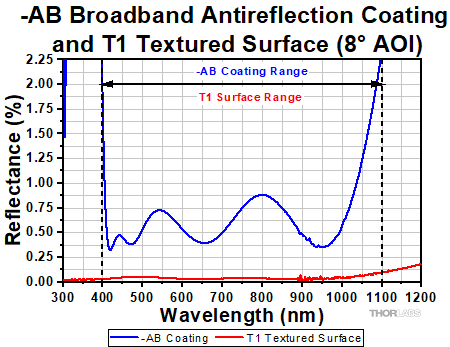 Click to Enlarge
Click to EnlargeComparison of Thorlabs' -AB broadband BBAR coating and the T1 textured surface reflectances. The -AB coating and T1 surface both have a 400 - 1100 nm wavelength range, which is indicated by the black arrow.
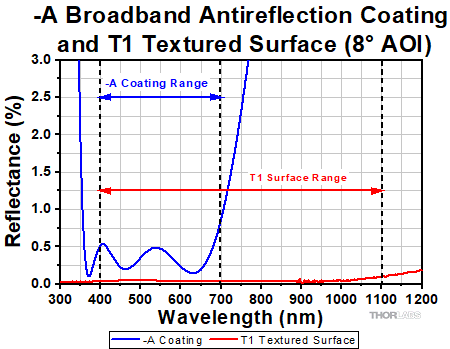 Click to Enlarge
Click to EnlargeComparison of Thorlabs' -A BBAR coating and the T1 textured surface reflectances. The blue arrow indicates the specified 350 - 700 nm wavelength range for the -A BBAR coating. The T1 surface wavelength range is indicated by the red arrow.
 Click to Enlarge
Click to EnlargeComparison of Thorlabs' -B BBAR coating and the T1 textured surface reflectances. The blue arrow indicates the specified 650 - 1050 nm wavelength range for the -B BBAR coating. The T1 surface wavelength range is indicated by the red arrow.
Angle of Incidence (AOI) and Polarization
Each performance plot shows the s- and p-polarized reflectance at several AOI for the T1 textured surface, -A coating, or -B coating when applied to a 1.0 mm-thick UVFS window (Item #'s W41010T1, WG41010-A, and WG41010-B, respectively). With their low angular sensitivities, the T1 surface reflectances are expected to stay relatively low over a large range of angles for both s- and p-polarized light. In contrast, the s-polarized reflectance values for the -A, and -B coatings are expected to rapidly rise with increasing AOI, while the p-polarized reflectance should show a slight decrease before increasing. The blue-shaded region indicates the specified wavelength range of each surface or coating.
| Damage Threshold Specifications | |
|---|---|
| Item # Suffix | Damage Threshold |
| T1 | >30 J/cm2 at 532 nm, 10 ns, 10 Hz, Ø0.4 mm |
Damage Threshold Data for Thorlabs' T1 Textured Antireflective Surface
The specifications to the right are measured data for Thorlabs' UV Fused Silica Windows with T1 Textured Surfaces. While measurements were performed on windows with planar surfaces, the results are equally applicable to lenses.
To demonstrate improved resistance to laser-induced damage, LIDT testing was performed on the W41010T1 textured window at 532 nm for fluences up to 50 J/cm2. Damage sites, which appear red in the exposure histogram below, are not observed on the T1 textured window below 48 J/cm2. For a detailed description of the LIDT testing method, please see the Testing Method section of the Laser Induced Damage Threshold Tutorial below.

Click to Enlarge
Exposure Histogram for LIDT Testing on the W41010T1 Textured Window Measurement Beam Parameters: 532 nm, 10 ns, 10 Hz, Ø0.4 mm
| Laser Induced Damage Threshold Data | |||
|---|---|---|---|
| W41010T1 LIDT Testing Dataa | |||
| Fluence | # of Tested Locations |
Locations with Damage |
Locations Without Damage |
| 10 J/cm2 | 10 | 0 | 10 |
| 20 J/cm2 | 10 | 0 | 10 |
| 30 J/cm2 | 10 | 0 | 10 |
| 40 J/cm2 | 10 | 0 | 10 |
| 44 J/cm2 | 10 | 0 | 10 |
| 46 J/cm2 | 10 | 0 | 10 |
| 48 J/cm2 | 10 | 1 | 9 |
| 50 J/cm2 | 10 | 3 | 7 |
Laser Induced Damage Threshold Tutorial
The following is a general overview of how laser induced damage thresholds are measured and how the values may be utilized in determining the appropriateness of an optic for a given application. When choosing optics, it is important to understand the Laser Induced Damage Threshold (LIDT) of the optics being used. The LIDT for an optic greatly depends on the type of laser you are using. Continuous wave (CW) lasers typically cause damage from thermal effects (absorption either in the coating or in the substrate). Pulsed lasers, on the other hand, often strip electrons from the lattice structure of an optic before causing thermal damage. Note that the guideline presented here assumes room temperature operation and optics in new condition (i.e., within scratch-dig spec, surface free of contamination, etc.). Because dust or other particles on the surface of an optic can cause damage at lower thresholds, we recommend keeping surfaces clean and free of debris. For more information on cleaning optics, please see our Optics Cleaning tutorial.
Testing Method
Thorlabs' LIDT testing is done in compliance with ISO/DIS 11254 and ISO 21254 specifications.
First, a low-power/energy beam is directed to the optic under test. The optic is exposed in 10 locations to this laser beam for 30 seconds (CW) or for a number of pulses (pulse repetition frequency specified). After exposure, the optic is examined by a microscope (~100X magnification) for any visible damage. The number of locations that are damaged at a particular power/energy level is recorded. Next, the power/energy is either increased or decreased and the optic is exposed at 10 new locations. This process is repeated until damage is observed. The damage threshold is then assigned to be the highest power/energy that the optic can withstand without causing damage. A histogram such as that below represents the testing of one BB1-E02 mirror.

The photograph above is a protected aluminum-coated mirror after LIDT testing. In this particular test, it handled 0.43 J/cm2 (1064 nm, 10 ns pulse, 10 Hz, Ø1.000 mm) before damage.

| Example Test Data | |||
|---|---|---|---|
| Fluence | # of Tested Locations | Locations with Damage | Locations Without Damage |
| 1.50 J/cm2 | 10 | 0 | 10 |
| 1.75 J/cm2 | 10 | 0 | 10 |
| 2.00 J/cm2 | 10 | 0 | 10 |
| 2.25 J/cm2 | 10 | 1 | 9 |
| 3.00 J/cm2 | 10 | 1 | 9 |
| 5.00 J/cm2 | 10 | 9 | 1 |
According to the test, the damage threshold of the mirror was 2.00 J/cm2 (532 nm, 10 ns pulse, 10 Hz, Ø0.803 mm). Please keep in mind that these tests are performed on clean optics, as dirt and contamination can significantly lower the damage threshold of a component. While the test results are only representative of one coating run, Thorlabs specifies damage threshold values that account for coating variances.
Continuous Wave and Long-Pulse Lasers
When an optic is damaged by a continuous wave (CW) laser, it is usually due to the melting of the surface as a result of absorbing the laser's energy or damage to the optical coating (antireflection) [1]. Pulsed lasers with pulse lengths longer than 1 µs can be treated as CW lasers for LIDT discussions.
When pulse lengths are between 1 ns and 1 µs, laser-induced damage can occur either because of absorption or a dielectric breakdown (therefore, a user must check both CW and pulsed LIDT). Absorption is either due to an intrinsic property of the optic or due to surface irregularities; thus LIDT values are only valid for optics meeting or exceeding the surface quality specifications given by a manufacturer. While many optics can handle high power CW lasers, cemented (e.g., achromatic doublets) or highly absorptive (e.g., ND filters) optics tend to have lower CW damage thresholds. These lower thresholds are due to absorption or scattering in the cement or metal coating.

LIDT in linear power density vs. pulse length and spot size. For long pulses to CW, linear power density becomes a constant with spot size. This graph was obtained from [1].

Pulsed lasers with high pulse repetition frequencies (PRF) may behave similarly to CW beams. Unfortunately, this is highly dependent on factors such as absorption and thermal diffusivity, so there is no reliable method for determining when a high PRF laser will damage an optic due to thermal effects. For beams with a high PRF both the average and peak powers must be compared to the equivalent CW power. Additionally, for highly transparent materials, there is little to no drop in the LIDT with increasing PRF.
In order to use the specified CW damage threshold of an optic, it is necessary to know the following:
- Wavelength of your laser
- Beam diameter of your beam (1/e2)
- Approximate intensity profile of your beam (e.g., Gaussian)
- Linear power density of your beam (total power divided by 1/e2 beam diameter)
Thorlabs expresses LIDT for CW lasers as a linear power density measured in W/cm. In this regime, the LIDT given as a linear power density can be applied to any beam diameter; one does not need to compute an adjusted LIDT to adjust for changes in spot size, as demonstrated by the graph to the right. Average linear power density can be calculated using the equation below.

The calculation above assumes a uniform beam intensity profile. You must now consider hotspots in the beam or other non-uniform intensity profiles and roughly calculate a maximum power density. For reference, a Gaussian beam typically has a maximum power density that is twice that of the uniform beam (see lower right).
Now compare the maximum power density to that which is specified as the LIDT for the optic. If the optic was tested at a wavelength other than your operating wavelength, the damage threshold must be scaled appropriately. A good rule of thumb is that the damage threshold has a linear relationship with wavelength such that as you move to shorter wavelengths, the damage threshold decreases (i.e., a LIDT of 10 W/cm at 1310 nm scales to 5 W/cm at 655 nm):

While this rule of thumb provides a general trend, it is not a quantitative analysis of LIDT vs wavelength. In CW applications, for instance, damage scales more strongly with absorption in the coating and substrate, which does not necessarily scale well with wavelength. While the above procedure provides a good rule of thumb for LIDT values, please contact Tech Support if your wavelength is different from the specified LIDT wavelength. If your power density is less than the adjusted LIDT of the optic, then the optic should work for your application.
Please note that we have a buffer built in between the specified damage thresholds online and the tests which we have done, which accommodates variation between batches. Upon request, we can provide individual test information and a testing certificate. The damage analysis will be carried out on a similar optic (customer's optic will not be damaged). Testing may result in additional costs or lead times. Contact Tech Support for more information.
Pulsed Lasers
As previously stated, pulsed lasers typically induce a different type of damage to the optic than CW lasers. Pulsed lasers often do not heat the optic enough to damage it; instead, pulsed lasers produce strong electric fields capable of inducing dielectric breakdown in the material. Unfortunately, it can be very difficult to compare the LIDT specification of an optic to your laser. There are multiple regimes in which a pulsed laser can damage an optic and this is based on the laser's pulse length. The highlighted columns in the table below outline the relevant pulse lengths for our specified LIDT values.
Pulses shorter than 10-9 s cannot be compared to our specified LIDT values with much reliability. In this ultra-short-pulse regime various mechanics, such as multiphoton-avalanche ionization, take over as the predominate damage mechanism [2]. In contrast, pulses between 10-7 s and 10-4 s may cause damage to an optic either because of dielectric breakdown or thermal effects. This means that both CW and pulsed damage thresholds must be compared to the laser beam to determine whether the optic is suitable for your application.
| Pulse Duration | t < 10-9 s | 10-9 < t < 10-7 s | 10-7 < t < 10-4 s | t > 10-4 s |
|---|---|---|---|---|
| Damage Mechanism | Avalanche Ionization | Dielectric Breakdown | Dielectric Breakdown or Thermal | Thermal |
| Relevant Damage Specification | No Comparison (See Above) | Pulsed | Pulsed and CW | CW |
When comparing an LIDT specified for a pulsed laser to your laser, it is essential to know the following:

LIDT in energy density vs. pulse length and spot size. For short pulses, energy density becomes a constant with spot size. This graph was obtained from [1].
- Wavelength of your laser
- Energy density of your beam (total energy divided by 1/e2 area)
- Pulse length of your laser
- Pulse repetition frequency (prf) of your laser
- Beam diameter of your laser (1/e2 )
- Approximate intensity profile of your beam (e.g., Gaussian)
The energy density of your beam should be calculated in terms of J/cm2. The graph to the right shows why expressing the LIDT as an energy density provides the best metric for short pulse sources. In this regime, the LIDT given as an energy density can be applied to any beam diameter; one does not need to compute an adjusted LIDT to adjust for changes in spot size. This calculation assumes a uniform beam intensity profile. You must now adjust this energy density to account for hotspots or other nonuniform intensity profiles and roughly calculate a maximum energy density. For reference a Gaussian beam typically has a maximum energy density that is twice that of the 1/e2 beam.
Now compare the maximum energy density to that which is specified as the LIDT for the optic. If the optic was tested at a wavelength other than your operating wavelength, the damage threshold must be scaled appropriately [3]. A good rule of thumb is that the damage threshold has an inverse square root relationship with wavelength such that as you move to shorter wavelengths, the damage threshold decreases (i.e., a LIDT of 1 J/cm2 at 1064 nm scales to 0.7 J/cm2 at 532 nm):

You now have a wavelength-adjusted energy density, which you will use in the following step.
Beam diameter is also important to know when comparing damage thresholds. While the LIDT, when expressed in units of J/cm², scales independently of spot size; large beam sizes are more likely to illuminate a larger number of defects which can lead to greater variances in the LIDT [4]. For data presented here, a <1 mm beam size was used to measure the LIDT. For beams sizes greater than 5 mm, the LIDT (J/cm2) will not scale independently of beam diameter due to the larger size beam exposing more defects.
The pulse length must now be compensated for. The longer the pulse duration, the more energy the optic can handle. For pulse widths between 1 - 100 ns, an approximation is as follows:

Use this formula to calculate the Adjusted LIDT for an optic based on your pulse length. If your maximum energy density is less than this adjusted LIDT maximum energy density, then the optic should be suitable for your application. Keep in mind that this calculation is only used for pulses between 10-9 s and 10-7 s. For pulses between 10-7 s and 10-4 s, the CW LIDT must also be checked before deeming the optic appropriate for your application.
Please note that we have a buffer built in between the specified damage thresholds online and the tests which we have done, which accommodates variation between batches. Upon request, we can provide individual test information and a testing certificate. Contact Tech Support for more information.
[1] R. M. Wood, Optics and Laser Tech. 29, 517 (1998).
[2] Roger M. Wood, Laser-Induced Damage of Optical Materials (Institute of Physics Publishing, Philadelphia, PA, 2003).
[3] C. W. Carr et al., Phys. Rev. Lett. 91, 127402 (2003).
[4] N. Bloembergen, Appl. Opt. 12, 661 (1973).
In order to illustrate the process of determining whether a given laser system will damage an optic, a number of example calculations of laser induced damage threshold are given below. For assistance with performing similar calculations, we provide a spreadsheet calculator that can be downloaded by clicking the button to the right. To use the calculator, enter the specified LIDT value of the optic under consideration and the relevant parameters of your laser system in the green boxes. The spreadsheet will then calculate a linear power density for CW and pulsed systems, as well as an energy density value for pulsed systems. These values are used to calculate adjusted, scaled LIDT values for the optics based on accepted scaling laws. This calculator assumes a Gaussian beam profile, so a correction factor must be introduced for other beam shapes (uniform, etc.). The LIDT scaling laws are determined from empirical relationships; their accuracy is not guaranteed. Remember that absorption by optics or coatings can significantly reduce LIDT in some spectral regions. These LIDT values are not valid for ultrashort pulses less than one nanosecond in duration.

A Gaussian beam profile has about twice the maximum intensity of a uniform beam profile.
CW Laser Example
Suppose that a CW laser system at 1319 nm produces a 0.5 W Gaussian beam that has a 1/e2 diameter of 10 mm. A naive calculation of the average linear power density of this beam would yield a value of 0.5 W/cm, given by the total power divided by the beam diameter:

However, the maximum power density of a Gaussian beam is about twice the maximum power density of a uniform beam, as shown in the graph to the right. Therefore, a more accurate determination of the maximum linear power density of the system is 1 W/cm.
An AC127-030-C achromatic doublet lens has a specified CW LIDT of 350 W/cm, as tested at 1550 nm. CW damage threshold values typically scale directly with the wavelength of the laser source, so this yields an adjusted LIDT value:

The adjusted LIDT value of 350 W/cm x (1319 nm / 1550 nm) = 298 W/cm is significantly higher than the calculated maximum linear power density of the laser system, so it would be safe to use this doublet lens for this application.
Pulsed Nanosecond Laser Example: Scaling for Different Pulse Durations
Suppose that a pulsed Nd:YAG laser system is frequency tripled to produce a 10 Hz output, consisting of 2 ns output pulses at 355 nm, each with 1 J of energy, in a Gaussian beam with a 1.9 cm beam diameter (1/e2). The average energy density of each pulse is found by dividing the pulse energy by the beam area:

As described above, the maximum energy density of a Gaussian beam is about twice the average energy density. So, the maximum energy density of this beam is ~0.7 J/cm2.
The energy density of the beam can be compared to the LIDT values of 1 J/cm2 and 3.5 J/cm2 for a BB1-E01 broadband dielectric mirror and an NB1-K08 Nd:YAG laser line mirror, respectively. Both of these LIDT values, while measured at 355 nm, were determined with a 10 ns pulsed laser at 10 Hz. Therefore, an adjustment must be applied for the shorter pulse duration of the system under consideration. As described on the previous tab, LIDT values in the nanosecond pulse regime scale with the square root of the laser pulse duration:

This adjustment factor results in LIDT values of 0.45 J/cm2 for the BB1-E01 broadband mirror and 1.6 J/cm2 for the Nd:YAG laser line mirror, which are to be compared with the 0.7 J/cm2 maximum energy density of the beam. While the broadband mirror would likely be damaged by the laser, the more specialized laser line mirror is appropriate for use with this system.
Pulsed Nanosecond Laser Example: Scaling for Different Wavelengths
Suppose that a pulsed laser system emits 10 ns pulses at 2.5 Hz, each with 100 mJ of energy at 1064 nm in a 16 mm diameter beam (1/e2) that must be attenuated with a neutral density filter. For a Gaussian output, these specifications result in a maximum energy density of 0.1 J/cm2. The damage threshold of an NDUV10A Ø25 mm, OD 1.0, reflective neutral density filter is 0.05 J/cm2 for 10 ns pulses at 355 nm, while the damage threshold of the similar NE10A absorptive filter is 10 J/cm2 for 10 ns pulses at 532 nm. As described on the previous tab, the LIDT value of an optic scales with the square root of the wavelength in the nanosecond pulse regime:

This scaling gives adjusted LIDT values of 0.08 J/cm2 for the reflective filter and 14 J/cm2 for the absorptive filter. In this case, the absorptive filter is the best choice in order to avoid optical damage.
Pulsed Microsecond Laser Example
Consider a laser system that produces 1 µs pulses, each containing 150 µJ of energy at a repetition rate of 50 kHz, resulting in a relatively high duty cycle of 5%. This system falls somewhere between the regimes of CW and pulsed laser induced damage, and could potentially damage an optic by mechanisms associated with either regime. As a result, both CW and pulsed LIDT values must be compared to the properties of the laser system to ensure safe operation.
If this relatively long-pulse laser emits a Gaussian 12.7 mm diameter beam (1/e2) at 980 nm, then the resulting output has a linear power density of 5.9 W/cm and an energy density of 1.2 x 10-4 J/cm2 per pulse. This can be compared to the LIDT values for a WPQ10E-980 polymer zero-order quarter-wave plate, which are 5 W/cm for CW radiation at 810 nm and 5 J/cm2 for a 10 ns pulse at 810 nm. As before, the CW LIDT of the optic scales linearly with the laser wavelength, resulting in an adjusted CW value of 6 W/cm at 980 nm. On the other hand, the pulsed LIDT scales with the square root of the laser wavelength and the square root of the pulse duration, resulting in an adjusted value of 55 J/cm2 for a 1 µs pulse at 980 nm. The pulsed LIDT of the optic is significantly greater than the energy density of the laser pulse, so individual pulses will not damage the wave plate. However, the large average linear power density of the laser system may cause thermal damage to the optic, much like a high-power CW beam.
| Recommended Mounting Options for Thorlabs Lenses | ||
|---|---|---|
| Item # | Mounts for Ø2 mm to Ø10 mm Optics | |
| Imperial | Metric | |
| (Various) | Fixed Lens Mounts and Mini-Series Fixed Lens Mounts for Small Optics, Ø5 mm to Ø10 mm | |
| (Various) | Small Optic Adapters for Use with Standard Fixed Lens Mounts, Ø2 mm to Ø10 mm | |
| Item # | Mounts for Ø1/2" (Ø12.7 mm) Optics | |
| Imperial | Metric | |
| LMR05 | LMR05/M | Fixed Lens Mount for Ø1/2" Optics |
| MLH05 | MLH05/M | Mini-Series Fixed Lens Mount for Ø1/2" Optics |
| LM05XY | LM05XY/M | Translating Lens Mount for Ø1/2" Optics |
| SCP05 | 16 mm Cage System, XY Translation Mount for Ø1/2" Optics | |
| (Various) | Ø1/2" Lens Tubes, Optional SM05RRC Retaining Ring for High-Curvature Lenses (See Below) |
|
| Item # | Mounts for Ø1" (Ø25.4 mm) Optics | |
| Imperial | Metric | |
| LMR1 | LMR1/M | Fixed Lens Mount for Ø1" Optics |
| LM1XY | LM1XY/M | Translating Lens Mount for Ø1" Optics |
| ST1XY-S | ST1XY-S/M | Translating Lens Mount with Micrometer Drives (Other Drives Available) |
| CXY1A | 30 mm Cage System, XY Translation Mount for Ø1" Optics | |
| (Various) | Ø1" Lens Tubes, Optional SM1RRC Retaining Ring for High-Curvature Lenses (See Below) |
|
| Item # | Mount for Ø1.5" Optics | |
| Imperial | Metric | |
| LMR1.5 | LMR1.5/M | Fixed Lens Mount for Ø1.5" Optics |
| (Various) | Ø1.5" Lens Tubes, Optional SM1.5RR Retaining Ring for Ø1.5" Lens Tubes and Mounts |
|
| Item # | Mounts for Ø2" (Ø50.8 mm) Optics | |
| Imperial | Metric | |
| LMR2 | LMR2/M | Fixed Lens Mount for Ø2" Optics |
| LM2XY | LM2XY/M | Translating Lens Mount for Ø2" Optics |
| CXY2 | 60 mm Cage System, XY Translation Mount for Ø2" Optics |
|
| (Various) | Ø2" Lens Tubes, Optional SM2RRC Retaining Ring for High-Curvature Lenses (See Below) |
|
| Item # | Adjustable Optic Mounts | |
| Imperial | Metric | |
| LH1 | LH1/M | Adjustable Mount for Ø0.28" (Ø7.1 mm) to Ø1.80" (Ø45.7 mm) Optics |
| LH2 | LH2/M | Adjustable Mount for Ø0.77" (Ø19.6 mm) to Ø2.28" (Ø57.9 mm) Optics |
| VG100 | VG100/M | Adjustable Clamp for Ø0.5" (Ø13 mm) to Ø3.5" (Ø89 mm) Optics |
| SCL03 | SCL03/M | Self-Centering Mount for Ø0.15" (Ø3.8 mm) to Ø1.77" (Ø45.0 mm) Optics |
| SCL04 | SCL04/M | Self-Centering Mount for Ø0.15" (Ø3.8 mm) to Ø3.00" (Ø76.2 mm) Optics |
| LH160CA | LH160CA/M | Adjustable Mount for 60 mm Cage Systems, Ø0.50" (Ø13 mm) to Ø2.00" (Ø50.8 mm) Optics |
| SCL60CA | SCL60C/M | Self-Centering Mount for 60 mm Cage Systems, Ø0.15" (Ø3.8 mm) to Ø1.77" (Ø45.0 mm) Optics |
Mounting High-Curvature Optics
Thorlabs' retaining rings are used to secure unmounted optics within lens tubes or optic mounts. These rings are secured in position using a compatible spanner wrench. For flat or low-curvature optics, standard retaining rings manufactured from anodized aluminum are available from Ø5 mm to Ø4". For high-curvature optics, extra-thick retaining rings are available in Ø1/2", Ø1", and Ø2" sizes.
Extra-thick retaining rings offer several features that aid in mounting high-curvature optics such as aspheric lenses, short-focal-length plano-convex lenses, and condenser lenses. As shown in the animation to the right, the guide flange of the spanner wrench will collide with the surface of high-curvature lenses when using a standard retaining ring, potentially scratching the optic. This contact also creates a gap between the spanner wrench and retaining ring, preventing the ring from tightening correctly. Extra-thick retaining rings provide the necessary clearance for the spanner wrench to secure the lens without coming into contact with the optic surface.
| Posted Comments: | |
| No Comments Posted |
 Products Home
Products Home








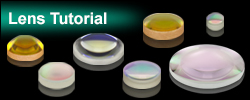

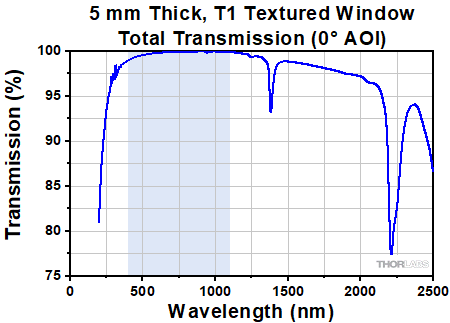

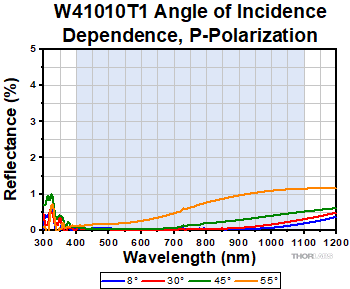

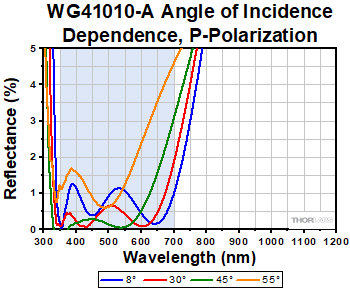



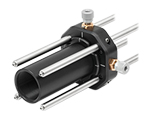




 UV Fused Silica, T1 Textured Surface
UV Fused Silica, T1 Textured Surface